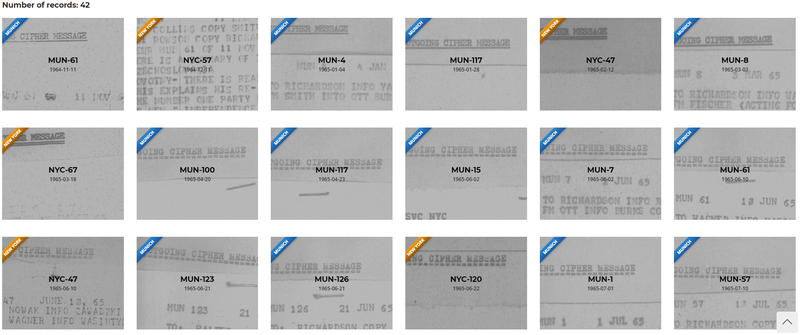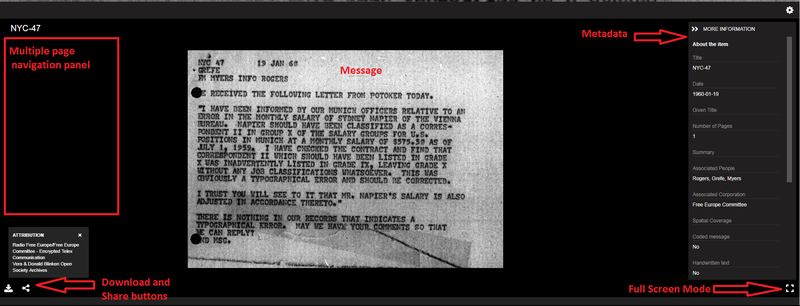The search engine has 6 fields you can use to filter the messages. The biggest and first empty field can be used to search for certain keywords from the description of the files.

The “Associated Places” filter presents the origin of the message. NYC/MUN/LIS corresponding to the place from where a message was sent.
“People as Contributors” filter selects the person responsible for the contents of a message. Please, consult with the “Basic structure of the message”.
“People as Subject” filter represents people mentioned in the body of a message.
“Corporations as Subject ” filter selects and displays the organizations/newspapers etc. mentioned in the body of a message.
“Country” filter selects the messages with countries mentioned.
The slider below the filters is the date filter. Drag it to select the date range you are interested in.
!Please, keep in mind! that the page will be updating every time you add a filter. Also, the contents of the dropdown menus will change accordingly to the updated info. After adding one filter, the rest will be displaying contents that are going together with the first.
After you have made the filter selection, results of your search are shown below.

You will see a set of images with the basic info on top of them. After clicking on it, you will be forwarded to the file viewer.

The message can be seen in the middle.
Its structure and specifics are explained below in the "Message guide".
You can drag and zoom it. On the left you can see if the document has multiple pages, and navigate through them. On left bottom corner there are share and download buttons.
On the right, there is a field with the meta data of the message: title, date, summary, associated people, etc. In the bottom right corner you can find the full screen button.
!Please note! if you see the error window, the refreshing of the page usually solves the issue.
To get back to the search results, press the "back" button in your browser.
Basic Structure of A Cipher (Encrypted) Message
a.) General Information
NYC/MUN/LIS - 49 - sending institution (New York FEC Office/Munich RFE/Lisbon) and a message number.
TO: main receiver
FROM: message author
COPY/INFO/CC: people to be notified about the message content
408PM - time
REF - reference to the previous messages
END MSG - end of message
NYC or MUN indicate the sending institutions. In this case, it is a message FROM the RFE/FEC office in New York, and the following digits refer to the number of messages (this is the 49th message sent) on that particular day of a month (July 1962). The receiving institution is not indicated, only the name of the person is given to whom it is addressed TO. COPY/INFO/CC other people from the management to be notified.
This message is from Minton in NYC to Smith, and copied to Burks and Richardson, as well. The exact time of the sending of the message is shown: 12:25 p.m., New York time.
Document Status
Some of the encrypted messages hold special information with “CONFIDENTIAL”, “STRICTLY CONFIDENTIAL”, “URGENT” or “EYES ONLY” stamps. With this status the creator wanted to prioritize the messages according to their importance and exclusivity for the RFE/FEC management. The urgency/secrecy status of the document reflects on the given historical moment or can also indicate the level of secrecy of the content distributed.
b.) Associated People - Names
The label “Associated People” contains information about the senders, recipients and copied recipients. Defining the participants in the communication is crucial in description of each message.
Because all the participants in the communication are identified usually only by their last name, it is sometimes difficult to clearly distinguish between people who share the same last name, or are spouses.
During the data consolidation, we did a preliminary search and created a list of possible matches. Please, feel free to consult it for your research.
!NOTE!: If you possess any personal archives or additional materials on the personalities from the list and are willing to share, please contact us.

c.) Document Encrypted
Some messages were encrypted by inserting a funny phrase or an unexpected and uncomprehending words in order to confuse those not authorized to read them. Sometimes messages include a set of words which look random at a first glance. However, these are usually coded names for protecting somebody’s identity or financial figures, or other delicate issues. Most often, they are crossed with a pen and decoded with a handwritten note on a top or bottom of the page.
Blinken OSA Blogs -
Mudrak, Anton. A Spy or Not a Spy: New Perspectives on the Most Famous Polish Spy Story through the Lens of Free Europe Committee/Radio Free Europe, OSA Blog, March 29, 2017, http://www.osaarchivum.org/blog/Spy-or-Not-Spy-New-Perspectives-most-famous-Polish-spy-story-through-lens-Free-Europe-Committee
Nakai, Anna. The Touch of the Cold War: The Free Europe Committee Encrypted Telex Communication, OSA Blog, March 1, 2018, http://www.osaarchivum.org/blog/Touch-Cold-War-Free-Europe-Committee-Encrypted-Telex-Communication
Parnica, Robert. Free Europe Committee – New Digital Collection Online, OSA Blog, January 28, 2016, http://www.osaarchivum.org/blog/Free-Europe-Committee-%E2%80%93-New-Digital-Collection-Online
Books -
Arch Puddington. “6. Revolution in Hungary and Crisis at Radio Free Europe.” In Broadcasting Freedom?: The Cold War Triumph of Radio Free Europe and Radio Liberty, 89. Lexington: The University Press of Kentucky, 2015.
Bischof, Anna, and Zuzana Jürgens, eds. Voices of Freedom-- Western Interference? 60 Years of Radio Free Europe. Göttingen: Vandenhoeck & Ruprecht, 2015.
Cummings, Richard H. Radio Free Europe’s “Crusade for Freedom”: Rallying Americans behind Cold War Broadcasting, 1950-1960. Jefferson, N.C: McFarland & Company, Inc, 2010.
Georgiev, Georgi. Cold War Engineering: Technical Infrastructure, Noise, and Geography in Radio Free Europe’s Operation in the 1950s and the 1960s. Budapest: Central European University, 2015.
Holt, Robert T. Radio Free Europe. Minneapolis?: University of Minnesota Press, 1958., n.d.
Ross Johnson A. and Parta, Eugene R. Cold War Broadcasting, Impact on the Soviet Union and Eastern Europe, A Collection of Studies and Documents, New York, 2010.
Johnson, A. Ross. “‘No One Is Afraid to Talk to Us Anymore.’: Radio Free Europe in 1989.” In The End and the Beginning, edited by Bogdan C. Iacob, NED-New edition, 1., 313–28. The Revolutions of 1989 and the Resurgence of History. Central European University Press, 2012. http://www.jstor.org/stable/10.7829/j.ctt2jbp94.13.
Johnson, A. Ross. Radio Free Europe and Radio Liberty: The CIA Years and beyond. Washington, D.C.?: Stanford, Calif: Woodrow Wilson Center Press?; Stanford University Press, 2010.
Kind-Kovacs, Friederike. Written Here, Published There, How Underground Literature Crossed the Iron Curtain, New York 2014
Machcewicz, Pawe?. Poland’s War on Radio Free Europe, 1950-1989. Washington, D.C.?; Stanford, Calif: Stanford University Press, 2014.
Michie, Allan A. Voices through the Iron Curtain: The Radio Free Europe Story. New York, NY: Dodd, Mead & Company, 1963.
Mickelson, Sig. America’s Other Voice: The Story of Radio Free Europe and Radio Liberty. New York, NY: Praeger Publishers, 1983.
Nelson, Michael. War of the Black Heavens: The Battles of Western Broadcasting in the Cold War. London: Brassey’s, 1997.
Parta, R. Eugene. Discovering the Hidden Listener: An Assessment of Radio Liberty and Western Broadcasting to the USSR during the Cold War: A Study Based on Audience Research Findings, 1970-1991. Hoover Institution Press Publication, no. 546. Stanford: Hoover Institution Press, 2007.
Pelz, William A., ed. “Europeans in the Cold War:: Between Moscow and Washington.” In A People’s History of Modern Europe, 171–82. Pluto Press, 2016. http://www.jstor.org/stable/j.ctt1c2crfj.17.
Puddington, Arch. Broadcasting Freedom: The Cold War Triumph of Radio Free Europe and Radio Liberty. Lexington, Ky: The University Press of Kentucky, 2000.
Révész, Béla. Documents on the Dictatorship and the Cold War in the Hungarian Archives: The Case of RFE. Szeged: Szegedi Tudományegyetem Állam- és Jogtudományi Kar, 2005.
Tkacheva, Olesya, Lowell H. Schwartz, Martin C. Libicki, Julie E. Taylor, Jeffrey Martini, and Caroline Baxter, eds. “Information Freedom During the Cold War:: The Impact of Western Radio Broadcasts.” In Internet Freedom and Political Space, 149–84. RAND Corporation, 2013. http://www.jstor.org/stable/10.7249/j.ctt4cgd90.14.
Urban, G. R. Radio Free Europe and the Pursuit of Democracy: My War within the Cold War. New Haven: Yale University Press, 1997.
Articles -
“Fantastic Truths, Compelling Lies: Radio Free Europe and the Response to the Slansky Trial in Czechoslovakia.” Contemporary European History 22, no. 1 (February 2013): 107–25.
Forbes, Malcolm S., Sudarsan V. Raghavan, Stephen S. Johnson, and Kristi K. Bahrenburg. “Sending Cross-Border Static: On the Fate of Radio Free Europe and the Influence of International Broadcasting.” Journal of International Affairs 47, no. 1 (1993): 73–87.
Foster Leich, John. Great Expectations: The National Councils in Exile 1950-60, The Polish Review, Vol XXXV No. 3, 1990
Granville, Johanna. “‘Caught with Jam on Our Fingers’: Radio Free Europe and the Hungarian Revolution of 1956.” Diplomatic History 29, no. 5 (2005): 811–39.
Kasprzak, Michal. “Radio Free Europe and the Catholic Church in Poland During the 1950s and 1960s.” Canadian Slavonic Papers / Revue Canadienne Des Slavistes 46, no. 3/4 (2004): 315–41.
Kaylan, Melik. “Losing the Propaganda Wars.” World Policy Journal 23, no. 4 (2006): 19–26.
Nekola, Martin. Free Europe Committee , Transatlantic Perspectives , 2016, Transatlantic Perspectives. 18 Jan 2016 http://www.transatlanticperspectives.org/entry.php?rec=148
Pirker, Peter. “Broker of Transnational Anticommunism: G. E. R. Gedye and Radio Free Europe in Austria.” Zeitgeschichte 43, no. 6 (December 2016): 379.
Siekierski, Maciej. “The Hoover Institution Collections on Poles in the United States.” Polish American Studies 60, no. 1 (2003): 19–21.
Sorensen, Robert C. “Radio Free Europe and Its Audience-Publics.” The Midwest Sociologist 18, no. 2 (1956): 16–19.
Trapans, Jan Arveds. “The Baltic States And Western Radio Broadcasts: The Role And Estimated Impact of Radio Free Europe.” Journal of Baltic Studies 19, no. 2 (1988): 93–100.
Uttaro, Ralph A. “The Voices of America in International Radio Propaganda.” Law and Contemporary Problems 45, no. 1 (1982): 103–22.
Zawodny, J.K. “The Polish Section of Radio Free Europe, 1952-56: War For The Minds of Men.” Edited by Jan Nowak. The Polish Review 31, no. 4 (1986): 317–21.
Ownership of and financial copyrights to the reports belong to RFE/RL, Inc. Reprinted with the permission of Radio Free Europe/Radio Liberty, 1201 Connecticut Ave., N.W., Washington, DC 20036, USA. Users of RFE/RL content cannot alter the meaning, name or integrity of the content. RFE/RL reserves the right to revoke permission for use of its content at any time. The sale of RFE/RL content is strictly prohibited.
Rights Reserved - Free Access - https://www.europeana.eu/portal/en/rights/rr-f.html